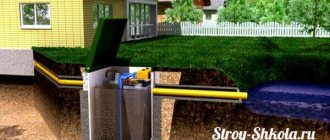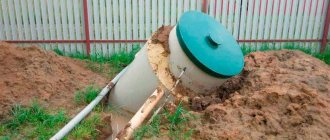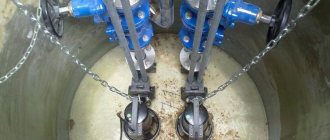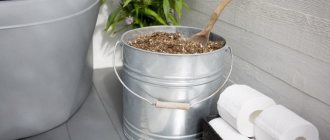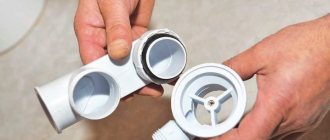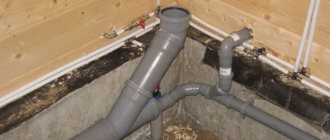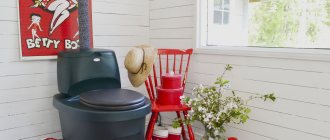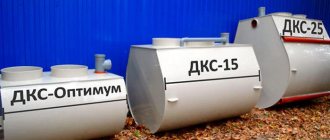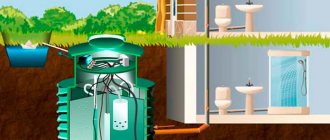When there is no way to connect to a centralized sewerage system on a site, many people buy septic tanks for their dachas. Which one is better – we’ll look at it in this material. A septic tank is quite capable of solving the problem of wastewater, and saving the owner from the need to pollute the environment. Of course, there are certain requirements for its installation, and for the design itself. But we will try to figure out how to choose a suitable septic tank for a dacha. Also for your attention are the TOP best brands whose products you can trust.
Sewerage Topas
Topas has long become a familiar name in the lists of leading manufacturers of autonomous sewage systems. Are released. They have their own on-line support and post-warranty service. They often provide discounts, and the cost starts from 71,000 rubles for 4 people. The range is very wide, for various houses to cottage villages.
They are characterized by low energy consumption. They have a wastewater treatment rate of 98%.
Thanks to the equipment installed in them, stations (septic tanks) effectively neutralize odors, show good performance and highly effective filtration. Reliable case.
Very popular septic tanks, good service, trouble-free repairs, ease of operation and low maintenance requirements. Equipped with compressors. One compressor is a cheaper model with the letter “C”. All classic models do not contain such a letter in the name and have 2 compressors. Can be connected to pipes at a depth of more than 1.5 meters. Topas models can be supplemented with a grease trap, solenoid valve, and ultraviolet post-treatment unit to make it possible to discharge the treated wastewater into water bodies.
The company’s product range also includes the Topaero line - installations that accept an increased volume of salvo discharge. Convenient to use when installing an autonomous sewer system for several houses.
Advantages
- The wastewater is 98% purified, so the water is safe for animals and plants;
- No unpleasant odor and noiselessness;
- Possibility of installation in any type of soil;
- Low maintenance requirements and service life of Topas is at least 50 years;
- Wide range of Topas models;
- Space saving - Topas does not take up much space.
Popular Topas models
Autonomous sewage system TOPAS 4
- Number of users 4
- Productivity 0.8 m3/day
- Salvo release 175 l
- Inset depth 40 - 85 cm
Price: 78 030
R.
–10%
Autonomous sewage system TOPAS 4 Pr
- Number of users 4
- Productivity 0.8 m3/day
- Salvo release 175 l
- Inset depth 40 - 85 cm
Price: 88 470
R.
–10%
Autonomous sewage system TOPAS 5
- Number of users 5
- Capacity 1 m3/day
- Salvo discharge 220 l
- Inset depth 40 - 90 cm
Price: 89 550
R.
–10%
Autonomous sewage system TOPAS 6
- Number of users 6
- Capacity 1.15 m3/day
- Salvo release 250 l
- Inset depth 40 - 95 cm
Price: 94 950
R.
–10%
Rating of domestic offers
Despite the fact that the production of treatment facilities for local sewage systems in Russia began recently, some of the companies have already established themselves as reliable manufacturers. Their quality is in no way inferior to European standards. In addition, domestic models are cheaper than imported ones. According to consumer surveys, several companies are recognized as the best manufacturers of treatment facilities on the Russian market.
Eurobion
Thanks to the introduction of membrane technology into septic tanks of its own production, the Yubas production association has earned a worthy place in the ranking of domestic manufacturers. Their systems are considered reliable and work properly even after long periods of inactivity.
Eurobion cross-section, work diagram
Poplar
These septic tanks are produced by the Eco-Grand brand. Their models are famous for their high level of sewage treatment (99%). The manufacturer uses a non-standard scheme in the production of its products. Namely, open access to the primary sections simplifies maintenance of the treatment system. Garbage can be removed from them on your own, without the involvement of sludge extraction equipment.
Types of septic tanks Poplar
Aster
Specializes in the production of septic tanks. The products are offered under the Unilos brand. Guarantees a high degree of wastewater purification (about 75%). It produces several types of treatment facilities depending on the degree of complexity. The stations are complemented by special compressors responsible for the quality of cleaning. The purification process is carried out in several stages.
Septic tank Astra
Tank
The Russian one is responsible for the quality of this line of septic tanks. This company produces septic tanks with varying degrees of productivity:
- Compact in size with the ability to process up to 600 liters per day.
- High-performance models capable of cleaning about 1200 liters per day. The parameters of their products are similar to classic recycling stations operating using multi-stage technology.
Range of treatment facilities Tank
Triton
Products from the same company. They have several configurations and cleaning methods. They can process from 450 liters per day (“Mini”) to 750 liters per day.
Triton dimensions
Topas
All models under this brand consume little electricity. The structures consist of 4 wells. All stages of purification, including anaerobic, are carried out in them. The degree of wastewater purification is 98%.
Topas - top view
Tver
These septic tanks are manufactured by the Engineering Equipment trading house. The peculiarity of these structures is that sewage treatment can be carried out both chemically and biologically. Each station is equipped with a 4-level water clarification technology. It can, depending on the model, process 750-1500 cubic meters of wastewater in 1 day.
Tver in section
Rostock and Leader companies have also proven themselves well in the domestic market.
Which of the septic tanks listed above is the best is up to each individual to decide. There are no clear parameters or standards here. The main thing is that it satisfies all user requests, is easy to maintain/use, is inexpensive, and lasts a long time.
Sewerage Unilos-Astra
Unilos Astra - stations that provide real comfort to their users and have achieved almost 100% cleaning level. Are being produced. They combine two types of cleaning - mechanical and biological. Designed for long-term operation. They undergo a very thorough inspection before sale. Autonomous sewage system Unilos is well adapted for operation in Russian conditions. They have good reviews from users who have already purchased them.
Also a very good indicator of the strength of the case is the walls and partitions made of polypropylene, with a minimum thickness of 20 mm. Among the design features is the ability to be equipped with a post-treatment unit and a built-in sewage pumping station (SPS). Thanks to this, the output is the purest process water possible.
The stations are represented by a wide range of models. Depending on the modification, they vary depending on the pipeline length and burial depth. Insulated models are produced for cold climate zones.
Prices for stations from this manufacturer start from 62,000 rubles.
Advantages
- Deep biological wastewater treatment - 98%;
- Sealed housing that does not allow unpleasant odors to pass through;
- Silent operation of the station;
- Automatic operation of the station, which does not require constant monitoring;
- Durable, water-permeable body, no corrosion;
- Durability and reliability - service life of 50 years.
Popular models Unilos Astra
Autonomous sewage system Astra 3
- Number of users 3
- Productivity 0.6 m3/day
- Salvo release 150 l
- Inset depth 45 - 60 cm
Price: 68 000
R.
–15%
Autonomous sewage system Astra 5
- Number of users 5
- Capacity 1 m3/day
- Salvo release 250 l
- Inset depth 45 - 85 cm
Price: 84 150
R.
–15%
Autonomous sewage system Astra 8
- Number of users 8
- Capacity 1.6 m3/day
- Salvo release 350 l
- Inset depth 45 - 85 cm
Price: 101 150
R.
–15%
Autonomous sewage system Astra 10
- Number of users 10
- Capacity 2 m3/day
- Salvo release 550 l
- Inset depth 45 - 85 cm
Price: 135 575
R.
–15%
TOP 3 non-volatile septic tanks
All treatment plants discussed below are made of plastic, which guarantees a housing life of up to half a century. By default, all processes of overflowing wastewater into them occur by gravity, but it is also possible to install a drainage pump for pumping out purified water.
"TANK" - high-performance versatility
In first place in the ranking of anaerobic autonomous sewers is the Tank septic tank. The body is made of high-strength plastic with a thickness of 10–17 mm and stiffening ribs allow this installation not to be afraid of any loads arising from the ground in winter and spring. Flood and high groundwater, as well as soil heaving, are not a problem for the Tank.
Installation diagram of a septic tank “TANK” with an infiltrator
The wastewater treatment in this septic tank is carried out in two stages:
- Settling and clarification.
- Decomposition of organic matter using a biofilter.
Drainage of purified water occurs through an infiltrator. The presence of a high neck allows you to place the “Tank” at any depth, and the design of universal modules allows you to assemble a septic tank of a very large volume.
"TRITON" - variety of model range
The most compact model “Triton-Mini” is a single-chamber septic tank, which is ideal for country houses. It easily copes with wastewater up to 250 liters. And if a more powerful station is needed, then it is better to take “Triton-ED” or “Triton-N” with a capacity of 600 l/day and a volume of 1800 and 2000 liters, respectively.
Installation of autonomous sewage system "Triton-Mini"
A durable, sealed plastic housing prevents waste from getting into the ground. A wide range of models allows you to choose a unit with a volume from 2 to 40 cubic meters. And after cleaning, water is drained to a remote filtration field or infiltrator.
"AQUA-BIO" - high degree of purification in five chambers
Step-by-step treatment of wastewater in the Aqua-Bio septic tank occurs in five separate containers located in one building. In the first three chambers, gradual sedimentation of solid suspensions occurs, and in the last two, organic matter is decomposed by anaerobes living on a special bioload.
The presence of several cameras significantly increases the efficiency of autonomous sewage systems. As a result, 97–99% purified water, practically free of silt, reaches the filtration field. The drainage does not become clogged and will need to be cleaned less often.
The range includes models with a capacity from 600 to 1300 l/day. You can always choose the best option for a particular country house.
Sewerage Volgar
Volgar - deep wastewater treatment stations that meet all consumer requirements. Autonomous sewers Volgar are used for wastewater treatment, both for country houses and for other buildings for various purposes. Septic tanks work in all types of soil and in all climatic conditions. All structural elements are made of homogeneous polypropylene, which avoids corrosion. The cost of autonomous Volgar stations starts from 58,050 rubles for 3 people.
You can choose a Volgar septic tank with forced or gravity drainage of purified water. Options for water drainage depend on the type of soil at the installation site, as well as on the location relative to residential buildings, wells, sanitary protection zones and specially protected objects. Gravity drainage of water is recommended in soils such as sand and sandy loam. Forced drainage – in loam, clay.
Volgar autonomous sewers are suitable for year-round use. The stations purify water by 98%. Clean water can be used for irrigation and is safe for animals. Energy consumption is also reduced since only one compressor is required. Volgar autonomous sewers are compact, do not require high maintenance costs and are affordable.
Advantages
- The wastewater treatment rate reaches 98%;
- Suitable for any type of soil and climate conditions;
- The durable cylindrical body is not afraid of soil pressure;
- Small size, compactness of the station;
- Does not smell even close up due to the tightness of the case;
- Easy to install and maintain the station;
- Long service life - at least 50 years.
Popular Volgar models
Autonomous sewerage system Volgar 3 2030 C
- Number of users 3
- Productivity 0.6 m3/day
- Salvo release 190 l
Price: 73 170
R.
–10%
Autonomous sewerage Volgar 5 2360 C
- Number of users 5
- Capacity 1 m3/day
- Salvo release 280 l
Price: 80 100
R.
–10%
Autonomous sewerage Volgar 8 2360 C
- Number of users 8
- Capacity 1.6 m3/day
- Salvo discharge 520 l
Price: 95 400
R.
–10%
Autonomous sewerage Volgar 10 2360 C
- Number of users 10
- Capacity 2 m3/day
- Salvo release 690 l
Price: 123 840
R.
–10%
Series of ready-made septic tanks
Among the factory-assembled septic tanks, the following popular series of products from different manufacturers can be distinguished:
Rostock mini. These miniature installations in the form of a plastic cylinder weighing 3-4 kg perform the function of an autonomous storage device. Depending on the model, septic tanks have a volume of up to 900 liters. They are suitable for country houses where the flow does not exceed 200-250 liters per day. The cost is in the range of 20,000-26,000 rubles.
Installation of a small septic tank Rostock-mini
Aster. These septic tanks provide anaerobic treatment. Productivity is 1-1.5 m3 per day. A septic tank can provide permanent residence for up to 4-5 people in a house. The price of the device is 75,000-82,000 rubles.
Construction of a septic tank Unilos Astra
Bioxi. The design includes a compressor, and therefore the device belongs to the equipment of the volatile category. In terms of technical parameters, the septic tank is close to the previous version. Its cost can reach 92-95 thousand rubles.
Construction of a septic tank from Bioxi
DKS. The septic tank of this series has 4 chambers, which ensures a high degree of purification. It is installed in areas with deep groundwater. Productivity exceeds 200 liters per day. Minimum sizes ensure low cost - in the range of 20,000-24,000 rubles.
Exterior view of the DKS septic tank
Leader. It is made of high-strength polyethylene and contains 4 chambers for deep wastewater treatment. A large number of models allows you to choose from a wide range of productivity - from 350 to 3200 liters per day. The device is intended to create a complete cleaning system, and therefore has an increased cost in the range of 80-180 thousand rubles.
VOC Leader scheme
Tank. Its body has a special ribbed structure, which ensures stability in moving and heaving soils. The cleaning system includes 3 chambers. The cost of the product ranges from 42,000-83,000 rubles.
Installation of septic tank Tank
Tver. The body of the septic tank is made of plastic with stiffening ribs that strengthen the structure. The septic tank has a specific, horizontal arrangement of the body. The system allows for a high degree of water purification. The price reaches 90-142 thousand rubles.
Septic tank installation Tver
Topas. This series of septic tanks is rightly recognized as one of the most popular. The degree of wastewater treatment exceeds 95%, which is ensured by a four-chamber structure. The body shape is rectangular with minimal dimensions. You can choose a model with different performance. The cost ranges from 78,000 to 320,000 rubles.
Operating principle of the Topas septic tank
Poplar. This is a fairly large design with a volume of more than 4500 liters with a productivity of more than 3000 liters per day. Septic tanks are of the energy-dependent type. The cost, depending on the model, ranges from 72 to 175 thousand rubles.
Example of a septic tank device Topol
Triton. The body of this unit is made of two-layer plastic. Well suited for small cottages with low runoff volume. The price is 28,000-83,000 rubles.
An example of a Triton septic tank device
Ecoline. Different models may contain 2 or 3 cameras. The volume varies widely from 1200 to 5000 liters. The average cost of the product is 53,000-56,000 rubles.
Ecoline septic tank installation
Elgad. This series represents the "mini" category. The volume of septic tanks does not exceed 1200 liters. Productivity allows you to serve permanent residence of 2-3 people. Cost – 34,000-37,000 rubles.
Elgad septic tank diagram
The modern market offers a wide range of septic tanks of various designs and performance. This makes it possible to optimally select equipment according to real dacha needs.
Sewerage Alta Bio
Alta Bio autonomous sewage systems are compact, safe and durable wastewater treatment plants, manufactured by Alta Group. Thanks to multi-stage purification, the output water is clear and has no unpleasant odor, and it can also be reused. The stations are not subject to corrosion, as they are made of polypropylene or polyethylene with a body thickness of 8 mm. The big advantage is that Alta Bio septic tanks do not require preservation for the winter; you just need to turn off the power supply.
Alta Bio septic tanks have different models that are designed for different numbers of people. Options for any type of soil are also presented. Alta Bio + models are designed for clay soils with high groundwater levels. Alta Bio models without markings are installed in sandy soil.
Prices for septic tanks start from 74,000 rubles. The stations are designed for long-term operation, since the service life of the Alta Bio autonomous sewage system is 50 years.
Advantages
- High level of wastewater purification - 98%, thanks to the passage of wastewater through three settling tanks;
- Non-volatility – if there is a power outage, Alta Bio will continue to work automatically;
- It is possible to enable additional UV cleaning;
- Household waste does not affect the operation of the Alta Bio station;
- The appearance of unpleasant odors is excluded;
- Service life – 60 years.
Popular Alta Bio models
Autonomous sewage system Alta Bio 3
- Number of users 3
- Productivity 0.6 m3/day
- Salvo release 120 l
Price: 78 500
R.
Autonomous sewage system Alta Bio 3 +
- Number of users 3
- Productivity 0.6 m3/day
- Salvo release 120 l
Price: 107 500
R.
Autonomous sewage system Alta Bio 5
- Number of users 5
- Capacity 1 m3/day
- Salvo discharge 210 l
Price: 101 175
R.
Autonomous sewage system Alta Bio 7
- Number of users 7
- Capacity 1.4 m3/day
- Salvo release 270 l
Price: 127 500
R.
Existing types and features of septic tanks
Before moving on to discussing the correct choice of treatment design, it is worth saying what they are. First, let's divide them into three groups.
Table. Treatment groups.
| View | Description |
| Drives | The main function of such devices is the collection and accumulation of wastewater. The container simply stores them until the vacuum cleaner arrives. Such containers can be made of various materials. They are inexpensive, easy to maintain, and in fact, apart from calling a sewer truck, they don’t need anything else. Once the container has accumulated, it can no longer perform its functions, so it needs to be cleaned regularly, which is expensive. As such, water purification does not occur in it. It is best if the capacity of such a device is such that it can accommodate at least 10 cubic meters of waste. This option is suitable for use in a country house, provided that few people live there during the summer. The fewer drains, the less often you will have to call the vacuum cleaners. |
| Septic tanks | Such structures operate without a power source and consist of 2, 3 or 4 containers connected in series, in which the water goes through several stages of purification. We described a similar design in the section “How a septic tank works.” The purification process takes a long time, but the output can be almost 100% purified water. Such devices are durable and not hazardous to the environment, but they are quite expensive and require regular maintenance. Vacuum trucks will rarely have to be called for such a treatment, since the containers almost do not accumulate water. But it cannot be installed where groundwater is very close. |
| Aeration | These are the most modern devices for wastewater treatment, the work of which is based not only on sedimentation processes, but also on the process of aeration and the work of microorganisms. But purified water is quite suitable for use for watering plants, and you can even simply pour it into a roadside ditch without fear of harming nature. Such devices consume electricity to operate, so they will not be efficient enough if there are any problems with this power source. Such installations are expensive and require careful and qualified treatment. |
Aeration septic tank
On a note! Aeration structures and settling tanks are considered purification septic tanks. Their cost varies widely and will depend on the principle of operation, size, level of water purification and a number of additional functions. They purify water from 58 to 98%.
Septic tanks can also be divided into volatile and non-volatile. The former, although they consume a small amount of energy, still consume it and lose their functionality when the power goes out. These are aerators and devices that have compressors and pumps. The degree of water purification in them is as high as possible. The second - non-volatile - are best suited for those conditions where there are power outages in areas. They are also suitable for people who do not want to spend money on electricity. These are storage tanks and settling tanks.
ERGOBOX sewerage
Ergobox stations are modern autonomous sewer systems that are ideal for a country house. – manufacturer of these stations. The septic tank provides deep wastewater treatment - 98%. The weight of the equipment does not exceed 150 kg. The sealed polyethylene body without seams is very durable and does not undergo deformation.
Autonomous sewers are available in two versions: with gravity and with forced drainage. Gravity discharge septic tanks are designed for areas with normal groundwater levels. Forced release stations are used for areas with high groundwater levels.
The cost of Ergobox stations starts from 58,900 rubles. The septic tank is easy to use and has a service life of 50 years. Ergobox autonomous sewers are durable, high-performance and undemanding in operation.
Advantages
- Multi-stage wastewater treatment – 98%;
- Lack of sewer odors due to the high degree of tightness of the housing;
- Invulnerability to corrosion due to the high-quality material of the Ergobox station;
- Reliable retention of the Ergobox station in the ground;
- Ergobox is suitable for any type of soil on the site;
- Long service life - 50 years or more.
Popular ERGOBOX models
Autonomous sewage system ERGOBOX 4 S
- Number of users 4
- Productivity 0.8 m3/day
- Salvo discharge 220 l
- Inset depth 90 cm
Price: 67 300
R.
Autonomous sewage system ERGOBOX 6 S
- Number of users 6
- Productivity 1.2 m3/day
- Salvo discharge 300 l
- Inset depth 90 cm
Price: 79 200
R.
Autonomous sewage system ERGOBOX 8 S
- Number of users 8
- Capacity 1.6 m3/day
- Salvo release 450 l
- Inset depth 90 cm
Price: 92 800
R.
Autonomous sewage system ERGOBOX 10 S
- Number of users 10
- Capacity 1.9 m3/day
- Salvo release 550 l
- Inset depth 90 cm
Price: 106 500
R.
Selection of sewer station (septic tank)
Design features
Based on their design and installation, septic tanks are divided into several types. First of all, it should be noted the autonomy mode. The following options are available:
- Autonomous septic tanks are storage tanks that do not depend on electricity or other power sources. They are also called septic tanks with pumping, because they require sewage disposal as the volume is filled.
- Energy-dependent septic tanks. This category includes systems with full or partial cleaning. They use pumps, relays and other electrical equipment, making them dependent on electricity.
Example of a septic tank with autonomous sewerage
An autonomous septic tank is most often a storage sewage system with pumping
Non-volatile septic tanks also include septic tanks with bacterial cleaning
Volatile options include a septic tank with a drainage or sewage pump
A septic tank with an aerator is another option for a volatile septic tank
Structurally, septic tanks can consist of one or several chambers. The simplest option is 1 storage tank. Septic tanks with cleaning can have 2 or 3 chambers depending on the depth of cleaning. When making a system with your own hands, 2 or 3 wells are built in succession, connected to each other by a pipe. Ready-made septic tanks are usually contained in one building. Chambers are formed inside using partitions.
There is a certain relationship with the number of chambers and the volume of drainage:
- Single chamber option. It is used when the flow is no more than 1.5 m3 per day.
- Septic tanks with 2 chambers. Their capabilities are limited to a runoff volume of 9-10 m3 per day.
- Three-chamber structures. They are capable of purifying liquid with a capacity of over 10 m3 per day.
An example of a single-chamber septic tank
An example of a two-chamber septic tank
An example of a three-chamber septic tank
Scheme for selecting a treatment plant depending on the groundwater level
Why professional installation of autonomous sewerage?
Installation of an autonomous sewer system itself is simple and does not require large expenses, but equipment and skills are required. An installation error can lead to very high costs in the future. And most importantly, there is no warranty when installing it yourself.
Stages of work:
- Mark a place in the ground, dig a pit and prepare everything for further pipe laying;
- Install a septic tank;
- Connect to the pipe system, hermetically sealing the entry and exit points from the station;
- Backfill the pit and trenches. When filling the pit, fill the station with water;
- Install and connect the pump and compressor;
- Connect to the electrical network;
- Put the sewerage station into operation.
To save money, you can complete the first, second and fourth points yourself by studying the technical data sheet of the treatment plant, and order installation supervision, direct installation of the station and its connection. But be prepared that you will have to read a lot, study the site and design a drainage system, dig a hole of the required size, prepare a trench for the pipeline, order sand, etc. equipment. It is necessary to comply with all SNiP standards and remember the rules for laying water supply and sewer pipes.
The service life of septic tanks is more than 50 years, and only competently carried out work guarantees operation during this time. Therefore, an autonomous sewerage system with turnkey installation is a more profitable solution than self-installation. Professional engineers are familiar with all the nuances of working with wastewater treatment plants, in different types of soil and in different areas. We also recommend purchasing the station and ordering its installation only from official dealers of the manufacturers.
Turnkey autonomous sewerage from the PORT company is a guarantee of professional installation and assistance at all stages of purchase and installation.
Sewer maintenance
Further maintenance is quite simple. Regular cleaning is important
– according to manufacturers’ passports, but
at least once a year
. During the warranty period - strictly according to the passport. It is necessary to periodically measure the concentration of sludge and remove it. It is worth monitoring the appearance of solids inside and traces of corrosion.
The operation of the compressor also needs to be checked at least once every 3 years.
If you have concerns about the operation of the septic tank, or the alarm has gone off, you should call specialists.
A one-time station maintenance visit includes:
- Diagnostics of the operation of the sewerage station;
- Pumping out excess sludge and solids;
- Cleaning the station inside: filters, pumps, hair trap, grease trap;
- Cleaning air duct nozzles;
- Washing the interior walls.
Service and support
365 days a year!
from 5,000 rubles
20% discount
For annual maintenance upon signing a contract on the day of installation!
How to choose the best septic tank for your dacha
When choosing a septic tank or before starting to build one, you need to take into account a lot of nuances. This includes the size of the territory, what is located on the site and where, the number of people in the family, and much more. First of all, you need to take into account the amount of wastewater on the site that is generated during the day. It is this that determines what volume of septic tank is required and with what productivity. In order to calculate this indicator, you need to know how many people will use the device constantly, how often guests come, whether dishes are often washed in the house or a lot of laundry is done.
On average, one resident receives 0.15-0.3 cubic meters of wastewater per day, that is, 150-300 liters. However, it is worth taking a septic tank of such a volume that there is always a small reserve in case of unforeseen situations when the load on the structure suddenly becomes greater. The reserve should be about 30% of the selected volume.
Recommendations for septic tank volume
If we talk about the installation depth of the septic tank, then the optimal indicators will be 1.5-3 meters, depending on the size of the device itself. By the way, it is important to understand that the deeper the septic tank, the more difficult it will be to pump out the sediment from its bottom.
Another important parameter is the characteristics of the soil on the site and the groundwater horizon. The overall possibility of installing this or that type of structure and the possibility and speed of water filtration through the ground at the last stage depend on this. Clay soils practically do not filter water, so you will have to organize excavation work to replace part of the soil with crushed stone and sand. In such conditions, a septic tank equipped with a biofiltration function is best suited, and the resulting purified water is then proposed to be used for various needs such as watering the garden. As an option, in clay soil conditions, you can simply install storage tanks.
By the way, some models of septic tanks are prohibited from being installed where there are moving soils or where groundwater is too close to the surface. Such conditions can create a dangerous situation that can lead to a leak in the structure and release of dirty water into the environment. The result is poisoning of the soil and water in it. There must be at least 1 m of soil thickness between the groundwater horizon and the bottom of the septic tank. More precisely, we are not talking about the bottom of the septic tank as such, but about the bottom of the filtration well - before water enters the groundwater, it must pass through the soil itself in order to be further purified and not cause harm to nature. Where groundwater is too close, you will have to use sealed tanks to collect purified water and pump the liquid out of them. Also in this case, you can use facilities with biological wastewater treatment.
Important! How often people visit the dacha also plays a role. For example, in case of rare visits, devices with biological treatment are definitely not suitable, since anaerobic bacteria will die if they lack food. They constantly need “fresh” drains.
If you don’t have a lot of money, the easiest way is to choose a drive of sufficient capacity. The cheapest option is the plastic one. It will just need to be cleaned regularly, at least once a year.
If someone decides to build so-called filtration fields instead of a filtration well, then he must take into account that he will need a large free area. Filtration fields require at least 30 square meters of area. Moreover, the distance to the house, garden and other structures must be sufficient and meet certain standards.
The configuration of the septic tank is also an important point. For some of them, especially for biological treatment stations, you will need to purchase a special compressor. You may also need drainage pumps to help circulate the water inside the septic tank.
Operating principle of autonomous systems
Modern septic tanks are based on multi-stage filtration of wastewater in a continuous mode. The internal space of the VOC is divided into parts:
- hermetically sealed or interconnected settling chambers;
- sections with equipment and measuring instruments.
The software monitors the state of the system. Pumps pump water from one chamber to another. The compressor is responsible for providing oxygen. Technologies involved in the work:
- mechanical filtration during the supply and settling of wastewater;
- biological processing of sludge by aerobic bacteria;
- additional cleaning.
Filters trap solid particles and grease. In addition to mechanical cleaning, colonies of bacteria work in special chambers. The result of VOC operation is clean water and a small mass of sludge.
After installation, bacterial strains are placed in the receiving compartment. Protozoa reproduce in the presence of oxygen in the atmosphere and the presence of sediment (silt). During biological treatment, there is no release of hydrogen sulfide: the sewer system operates odorless.
The durability of the equipment depends on the strength of the housing. The casing can withstand significant mechanical loads and is resistant to soil chemicals. If the owner follows the recommendations of specialists, the device will work for 50 years (without dismantling).
After installation and connection of communications, the factory system is ready for operation. Among the most popular product brands: Topas, Astra, Volgar, Alta Bio, ERGOBOX
How does an autonomous sewer work?
- Reception chamber
- Coarse filter
- Main airlift
- Aerotank
- Secondary settling tank of aeration tank
- Storage tank for forced removal of treated waste
- Airlift recycling
- Sludge stabilizer
- Secondary sludge stabilizer settling tank
- Service airlift
- Compressor
- Sealed cable glands
The principle of operation of sewerage in a country house
The inlet filter does not allow large waste to pass through. In the first compartment, processes take place: the initial purification of wastewater from mechanical particles and the capture of traces of fat.
The second stage is the processing of sludge by aerobic microorganisms. Sludge is a breeding ground for bacteria. The result of active biofiltration is wastewater purification by 80%.
The third stage is anaerobic processing of sewage waste. Fine cleaning neutralizes microorganisms that did not react in the second stage. There are combined systems that ensure the coexistence of aerobic and anaerobic bacteria.
Additional processing takes place at the finish line. The liquid is passed through volcanic powder. The treated wastewater is discharged into a tunnel to be directed to a storm drain or used for domestic needs.
Septic tank installation.
The structure of a septic tank is a sealed round container made of fiberglass with three sequentially placed chambers, which are separated by partitions. Effluent from the house enters the first receiving chamber, solid particles settle to the bottom, and clarified water flows through the partition into the second chamber. In the second chamber, what did not settle in the first settles to the bottom, and the water flows through the partition into the third chamber. There, the remaining sediment, which did not settle in the previous two, settles to the bottom and 60-70% purified water flows into a filtration well or filtration field for further purification in the ground.
Septic tanks made of fiberglass are more practical to use. They are stronger and will not be chewed by mice and other rodents living on your property, since the plastic contains fiberglass, and rats do not really like gnawing glass.
